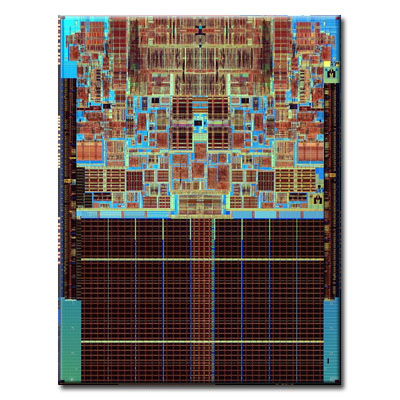Intel Core 2 (Conroe) processors
Introduction: July 2006
Overview
The Core 2 brand refered to a range of Intel's consumer 64-bit dual-core and 2x2 MCM quad-core CPUs with the x86-64 instruction set, based on the Intel Core microarchitecture, derived from the 32-bit dual-core Yonah laptop processor. Note: the Yonah's silicon chip or die comprised two interconnected cores - each similar to those branded Pentium M. The 2x2 MCM dual-die quad-core CPU had two separate dual-core dies (CPUs) - next to each other - in one quad-core MCM package. The Core 2 relegated the Pentium brand to a lower-end market, and reunified laptop and desktop CPU lines, which previously had been divided into the Pentium 4, D, and M brands.
The Core microarchitecture returned to lower clock speeds and improved processors' usage of both available clock cycles and power compared with preceding NetBurst of the Pentium 4/D-branded CPUs. Core microarchitecture provided more efficient decoding stages, execution units, caches, and buses, reducing the power consumption of Core 2-branded CPUs, while increasing their processing capacity.
The Core 2 brand was introduced on July 27, 2006 comprising the Solo (single-core), Duo (dual-core), Quad (quad-core), and Extreme (dual- or quad-core CPUs for enthusiasts) branches, during 2007.
The Core 2-branded CPUs included: "Conroe" and "Allendale" (dual-core for higher- and lower-end desktops), "Merom" (dual-core for laptops), "Kentsfield" (quad-core for desktops), and their variants named "Penryn" (dual-core for laptops), "Wolfdale" (dual-core for desktops) and "Yorkfield" (quad-core for desktops). Note: for the server and workstation "Woodcrest", "Clovertown", and "Tigerton" CPUs saw the Xeon brand.
The Core 2 branded processors featured the Virtualization Technology (except T52x0, T5300, T54x0, T55x0 with stepping "B2", E2xx0, E4x00 and E8190 models), Execute Disable Bit, and SSE3. Their Core microarchitecture introduced also SSSE3, Trusted Execution Technology, Enhanced SpeedStep, and Active Management Technology (iAMT2). With a Thermal Design Power (TDP) of up to only 65W, the Core 2 dual-core Conroe consumed only half the power of less capable, but also dual-core Pentium D-branded desktop chips with a TDP of up to 130W (a high TDP requires additional cooling that can be noisy or expensive).
The Conroe core
The first Intel Core 2 Duo branded processor cores, code-named Conroe (Intel product code 80557), were launched on July 27, 2006, at Fragapalooza, a yearly gaming event in Edmonton, Alberta, Canada. These processors were fabricated on 300 mm wafers using a 65 nm manufacturing process, and intended for desktop computers, as a replacement for the Pentium 4 and Pentium D branded CPUs. Intel had claimed that Conroe provides 40% more performance at 40% less power compared to the Pentium D. All Conroe processors were manufactured with 4MB L2 cache; however, due to manufacturing defects or possibly for marketing purposes, the E6300 and E6400 versions based on this core had half their cache disabled, leaving them with only 2MB of usable L2 cache. These Conroe-based E6300 and E6400 CPUs had the B2 stepping.
The lower end E6300 (1.86GHz) and E6400 (2.13GHz), both with a 1066MT/s FSB, were released on July 27, 2006. Traditionally, CPUs of the same family with less cache simply had the unavailable cache disabled, since this allowed parts that fail quality control to be sold at a lower rating. When yields improved, they were replaced with versions that only had the cache amount needed on the die, to bring down manufacturing cost. At launch time, Intel's prices for the Core 2 Duo E6300 and E6400 processors were US$183 and US$224 each in quantities of 1000. Conroe CPUs had improved capabilities over previous models with similar processor speeds. According to reviews, the larger 4MB L2 cache vs. the smaller 2MB L2 cache at the same frequency and FSB was able to provide a 0–9% performance gain with certain applications and 0–16% performance gain with certain games. The higher end Conroe processors were the E6600 (2.4GHz) and E6700 (2.67GHz) Core 2 Duo models. The family had a 1066MT/s front side bus, 4MB shared L2 cache, and 65 watts TDP. These processors had been tested against AMD's then-current top performing processors (Athlon 64 FX Series), which were, until this latest Intel release, the fastest CPUs available. Conroe chips also experienced much lower heat output compared to their predecessors - a benefit of the new 65 nm technology and the much more efficient microarchitecture. At launch time, Intel's prices for the Core 2 Duo E6600 and E6700 processors were US$316 and US$530, respectively, each in quantities of 1000.
E6320 and E6420 Conroe CPUs at 1.86 and 2.13GHz respectively were launched on April 22, 2007 featuring a full 4MB of cache and were considered Conroes.
Intel released four additional Core 2 Duo Processors on July 22, 2007. The release coincided with that of the Intel Bearlake (x3x) chipsets. The new processors were named Core 2 Duo E6540, E6550, E6750, and E6850. Processors with a number ending in "50" had a 1333MT/s FSB. The processors all had 4MB of L2 cache. Their clock frequency was similar to that of the already released processors with the same first two digits (E6600, E6700, X6800). An additional model, the E6540, was launched with specifications similar to the E6550 but lacking Intel Trusted Execution Technology and vPro support. These processors were slated to compete with AMD's Stars processor line and were therefore priced below corresponding processors with a 1066MT/s FSB.
Source: Wikipedia, the free encyclopedia.


